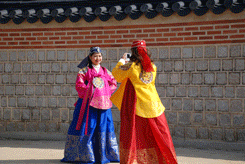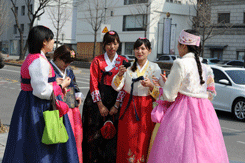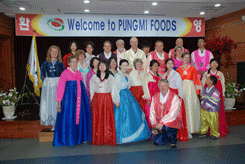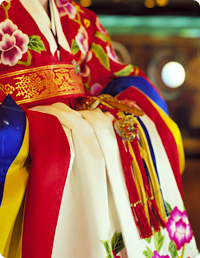Hanbok
 |
 |
 |
Traditional clothing is called "Hanbok," an abbreviation of the term Hangukboksik (Korean attire). Hanbok forms a highly effective expression of Korean identity and changes in Hanbok design from the past to the present parallel the nation's historical development. Moreover, forms, materials and designs in hanbok provide a glimpse into Korean lifestyle, while its colors indicate the values and world view of the Koreans. Men’s Hanbok usually consisted of a broad hop-length jacket called Jeogori and baggy pants called Baji. As Baji were very roomy, they were bound with a belt of the same cloth at the waist, and the legs were tied at the ankles for convenience with straps called Daenim, overcoat (Durumagi), vest, outer coat (Magoja), and socks (Beoseon). Women’s clothes were composed of a shorter Jeogori and a Chima, a warp-around skirt. The skirt extended from the chest down to the ankles. In particular, as the skirt was wide at the hips, it looked like a bell. The Jeogori opened in front and tied gracefully with a Goreum, a butterfly-like ribbon attached to the Joegori. In addition to Chima and Jeogori, the women’s Hanbok attire is made up of undergarments, such as an undershirt (Sokjeogori), under pants (Gojaeng-i), inner skirt (Sokchima) and socks (Beoseon).In addtion, Ggotsin (flower shoes) and Norigae (ornaments) add the beauty of Hanbok attire.
Baji
It refers to the lower part of the man's Hanbok compared to western style pants, it does not fit tightly. The roomy nature of the cloth is due to a design aimed at making the cloth ideal for sitting on the floor.
Jeogori
The Jeogori makes up the upper part of Hanbok. Man's Jeogori are larger and simplistic while women's Jeogori are rather short and characterized by curved lines and delicate decorations.
Magoja
It is an outer coat worn over the Jeogori. Except for its sleeves, it is similar to a Jeogori, but it is about one centimeter longer than a Jeogori. It is cut so deep at the neck that the Git and Dongjeong, a white collar attached along the rim of the neckline, of the Jeogori are revealed. One or two buttons are used to fasten it instead of a Goreum.
Durumagi
It is a traditional overcoat worn on special occasions over the traditional jacket and pants.
Beoseon
They correspond to a pair of contemporary socks. Although the shape of the Beoseon does not reflect any difference in the gender of its users, men's Beoseon are characterized by a straight seam.
Chima
The Chima is the women's outer skirt. There are different kinds of Chima, single-layered, double-layered, and quilted. Pulchima refers to a Chima with a separated back, whereas a Tongchima has a seamed back.






